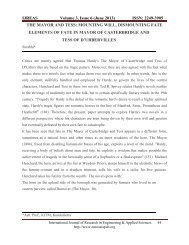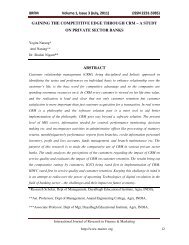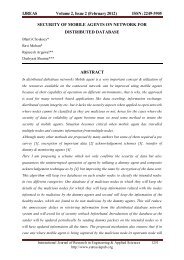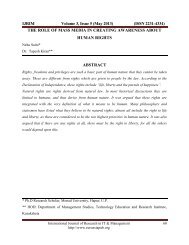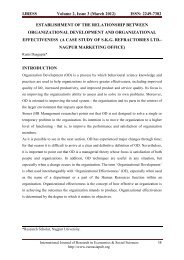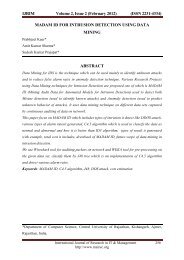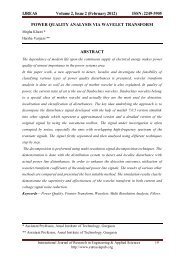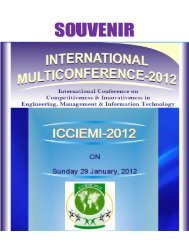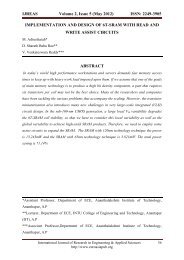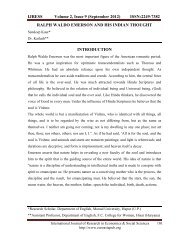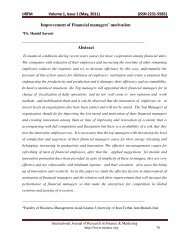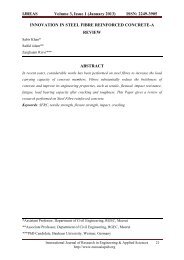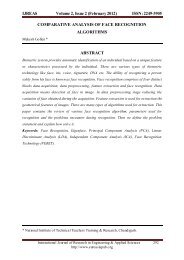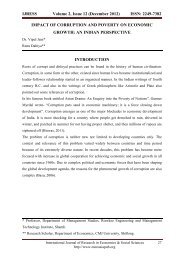mobile number portability in coimbatore - Euroasiapub.org
mobile number portability in coimbatore - Euroasiapub.org
mobile number portability in coimbatore - Euroasiapub.org
- No tags were found...
Create successful ePaper yourself
Turn your PDF publications into a flip-book with our unique Google optimized e-Paper software.
IJRIM Volume 2, Issue 2 (February 2012) ISSN: 2231-4334<br />
MOBILE NUMBER PORTABILITY IN COIMBATORE: AN<br />
EMPIRICAL ANALYSIS OF CONSUMER SWITCHING BEHAVIOR<br />
K Kumaresh *<br />
Dr.C.Sekar **<br />
ABSTRACT<br />
Indian <strong>mobile</strong> market is one of the fastest grow<strong>in</strong>g markets and is forecasted to reach 868.47<br />
million users by 2013. India has seen rapid <strong>in</strong>crease <strong>in</strong> the <strong>number</strong> of players which caused<br />
the tariff rates to hit an all time low. This allowed the players to target the low <strong>in</strong>come<br />
population thereby <strong>in</strong>creas<strong>in</strong>g the market share. The availability of a <strong>number</strong> of subscriber<br />
options for consumers and varied tariff rates of each player, lead the consumers to switch<br />
between service providers. Mobile <strong>number</strong> <strong>portability</strong> permits to a <strong>mobile</strong> subscriber to<br />
switch operators without chang<strong>in</strong>g his/her telephone <strong>number</strong>. This study focuses on the<br />
<strong>mobile</strong> <strong>number</strong> <strong>portability</strong> among the <strong>mobile</strong> users <strong>in</strong> Coimbatore.<br />
Mobile <strong>number</strong> <strong>portability</strong> is now a crucial issue for <strong>mobile</strong> service providers. The most<br />
challeng<strong>in</strong>g job for the present day is that reta<strong>in</strong> exist<strong>in</strong>g <strong>mobile</strong> customers. The <strong>mobile</strong><br />
operator’s ability to reta<strong>in</strong> its customer has a direct impact on its profitability and<br />
effectiveness. Los<strong>in</strong>g a customer will affect the <strong>mobile</strong> operators <strong>in</strong> terms of cost. Percentage<br />
analysis, Garrett rank<strong>in</strong>g and Factor Analysis were used for this research. The f<strong>in</strong>d<strong>in</strong>gs have<br />
revealed that Promotional offers and Service Affordability is the most important factor<br />
<strong>in</strong>fluenc<strong>in</strong>g the <strong>mobile</strong> subscriber Intention to switch service provider compared to Service<br />
Quality. From this study most of the respondents were satisfied with the Mobile Number<br />
<strong>portability</strong>.<br />
Keywords: Mobile Number Portability, Switch<strong>in</strong>g Behaviour, Service, Customer satisfaction.<br />
* Research Scholar, Department of ARM, TamilNadu Agricultural University, Coimbatore.<br />
** Professor, Agricultural Economics, PHTC, TamilNadu Agricultural University,<br />
Coimbatore.<br />
International Journal of Research <strong>in</strong> IT & Management 1119<br />
http://www.mairec.<strong>org</strong>
IJRIM Volume 2, Issue 2 (February 2012) ISSN: 2231-4334<br />
INTRODUCTION<br />
The telecom <strong>in</strong>dustry is one of the fastest grow<strong>in</strong>g <strong>in</strong>dustries <strong>in</strong> India. India has about 200<br />
million telephone l<strong>in</strong>es mak<strong>in</strong>g it the third largest network <strong>in</strong> the world after Ch<strong>in</strong>a and USA.<br />
With a growth rate of 45 per cent, Indian telecom <strong>in</strong>dustry has the highest growth rate <strong>in</strong> the<br />
world (www.telecommunications.com). The <strong>mobile</strong> communication plays a major role <strong>in</strong><br />
telecommunication <strong>in</strong>dustry. Indian telecommunication sector is prosperous as Indian<br />
economies are considerably good. Mobile network comes under the service sector, which is<br />
experienc<strong>in</strong>g a rapid development which <strong>in</strong> turn is support<strong>in</strong>g the growth <strong>in</strong> Indian economy,<br />
provides ample chances employment and self employment generation. As <strong>mobile</strong> <strong>number</strong><br />
<strong>portability</strong> has been <strong>in</strong>troduced <strong>in</strong> India, reta<strong>in</strong><strong>in</strong>g exist<strong>in</strong>g customers is now a very tough job<br />
for network providers. After the <strong>in</strong>troduction of <strong>mobile</strong> <strong>number</strong> <strong>portability</strong> <strong>in</strong> India, the<br />
<strong>mobile</strong> user’s switch<strong>in</strong>g turnover is more. This paper br<strong>in</strong>gs to light the reasons beh<strong>in</strong>d that<br />
Mobile Number Portability on Switch<strong>in</strong>g Behavior-Indian Mobile Market.<br />
Mobile Number Portability is the process by which, one can move to another operator of<br />
one’s choice, but one can reta<strong>in</strong> the old <strong>number</strong>. The advantage is that one need not have to<br />
go through the problem of <strong>in</strong>form<strong>in</strong>g all your friends & family that your <strong>number</strong> has changed<br />
- it stays the same. Subscriber can keep with the same technology, GSM/CDMA. Also shift to<br />
CDMA or vice versa. Both post-paid & prepaid subscribers can use it.<br />
Switch<strong>in</strong>g behavior is a consumer behavior where the behavior of the consumers differs<br />
based on the satisfactory level of the consumers with the providers or companies. Switch<strong>in</strong>g<br />
behavior can be enunciated as the process of be<strong>in</strong>g loyal to one service and switch<strong>in</strong>g to<br />
another service, due to dissatisfaction or any other problems. Even if a consumer is loyal to a<br />
particular brand, if the brand does not satisfy his/her needs, the consumers switch to a<br />
competitor brand. There are different factors and determ<strong>in</strong>ants which affect the consumers <strong>in</strong><br />
switch<strong>in</strong>g their service from one service to another. Los<strong>in</strong>g a consumer is a serious setback<br />
for the firm <strong>in</strong> terms of its present and future earn<strong>in</strong>gs. In addition to los<strong>in</strong>g the benefits<br />
discussed above, the firm needs to <strong>in</strong>vest resources <strong>in</strong> attract<strong>in</strong>g new consumers to replace the<br />
ones it has lost (advertis<strong>in</strong>g, promotion, <strong>in</strong>itial discounts). Consequently, reta<strong>in</strong><strong>in</strong>g the current<br />
consumer base is much more attractive and viable than search<strong>in</strong>g for new consumers<br />
History of Mobile <strong>number</strong> Portability<br />
Globally, the <strong>in</strong>troduction of MNP across markets has witnessed a mixed response from<br />
customers. The push for MNP implementation has always been led by market regulators <strong>in</strong> an<br />
effort to provide <strong>mobile</strong> customers with the freedom to move between service providers and<br />
International Journal of Research <strong>in</strong> IT & Management 1120<br />
http://www.mairec.<strong>org</strong>
IJRIM Volume 2, Issue 2 (February 2012) ISSN: 2231-4334<br />
drive healthier competition. Globally, among the major countries, S<strong>in</strong>gapore was the first to<br />
implement MNP In 1997, followed by Hong Kong, Australia, Germany, US and France etc.,<br />
MNP has been <strong>in</strong>troduced <strong>in</strong> India, <strong>in</strong> two phases. It has been <strong>in</strong>troduced first <strong>in</strong> Indian metro<br />
city and group A telecom zones, on December 31, 2009, and afterward <strong>in</strong> the rema<strong>in</strong><strong>in</strong>g part<br />
of the country, by March 20, 2010. Subscribers have to pay up all due bills before mak<strong>in</strong>g an<br />
application for MNP. The <strong>mobile</strong> port<strong>in</strong>g fee is to be paid to the latest operator. No fee<br />
payment is necessary to be given to the operator for port<strong>in</strong>g. TRAI said that port<strong>in</strong>g between<br />
<strong>mobile</strong> operators be supposed to be accomplished with<strong>in</strong> four days. Prepaid users must keep<br />
<strong>in</strong> m<strong>in</strong>d that their balance talk time and SMS will disappear if they switch to a different<br />
operator. Accord<strong>in</strong>g to the Indian telecom regulator TRAI, nearly 8.54 million subscribers<br />
were issued port<strong>in</strong>g requests <strong>in</strong> the month of April 2011, an <strong>in</strong>crease of 32.98% month on<br />
month. (www.mnp-<strong>in</strong>dia.com).<br />
PROBLEM FOCUS<br />
The present study seeks to exam<strong>in</strong>e the impact of Mobile Number Portability on <strong>mobile</strong> users<br />
Switch<strong>in</strong>g behavior-Indian <strong>mobile</strong> market. It aims to analyze the magnitude of <strong>mobile</strong><br />
<strong>number</strong> <strong>portability</strong>. An attempt is also made to identify the major factors <strong>in</strong>fluenc<strong>in</strong>g the<br />
switch<strong>in</strong>g behavior of <strong>mobile</strong> <strong>number</strong> <strong>portability</strong>. With greater choice and <strong>in</strong>creas<strong>in</strong>g<br />
awareness, Indian consumers are <strong>in</strong>creas<strong>in</strong>gly demand<strong>in</strong>g better quality of service or else<br />
switchover over to other better service. The ma<strong>in</strong> aim of this research is use to determ<strong>in</strong>e the<br />
effect of Mobile Number Portability (MNP) among the <strong>mobile</strong> users of Coimbatore.<br />
OBJECTIVES<br />
The general objective of the study was to f<strong>in</strong>d out network switch<strong>in</strong>g behavior of <strong>mobile</strong><br />
users. The specific objectives of the study are to f<strong>in</strong>d out the factors <strong>in</strong>fluenc<strong>in</strong>g customer<br />
<strong>mobile</strong> <strong>number</strong> <strong>portability</strong>, to identify the problems encounted by the respondents to<br />
switchover another service provider and to suggest strategies to reta<strong>in</strong> the customers for the<br />
service providers.<br />
CONCEPTS AND REVIEW<br />
Gerpott et al. (2001) <strong>in</strong>vestigated the structural relationships of subscriber retention,<br />
subscriber satisfaction, and loyalty <strong>in</strong> German <strong>mobile</strong> subscribers. He found that subscribers<br />
have positive impact towards the MNP.<br />
Jeong and Park (2003) exam<strong>in</strong>ed the difference of subscribers’ switch<strong>in</strong>g <strong>in</strong>tention before<br />
and after the <strong>in</strong>troduction of MNP <strong>in</strong> Korea. He reported that brand image, price and service<br />
were major factors of MNP.<br />
International Journal of Research <strong>in</strong> IT & Management 1121<br />
http://www.mairec.<strong>org</strong>
IJRIM Volume 2, Issue 2 (February 2012) ISSN: 2231-4334<br />
Yang and Choi (2003) identified factors of brand perceived level, service quality, a charge<br />
cut and value-added Service for the retention strategy of telecommunication carriers with<br />
MNP.<br />
Buehler and Haucap (2004) <strong>in</strong>vestigated the effect on MNP implementation on consumers’<br />
welfare. They reported that MNP implementation will benefit the entrant firm and will hurt<br />
the <strong>in</strong>cumbent.<br />
Lee et al. (2004) used cont<strong>in</strong>gent valuation techniques to estimate the prospective demand for<br />
MNP <strong>in</strong> South Korea. They found that they have positive attitude towards the <strong>mobile</strong> <strong>number</strong><br />
<strong>portability</strong> option.<br />
Pagani (2004) identified the determ<strong>in</strong>ants of adoption of 3G <strong>mobile</strong> multimedia services and<br />
found that perceived usefulness, ease of use, price, and speed of use are the most important<br />
determ<strong>in</strong>ants of adoption of 3G multimedia <strong>mobile</strong> services.<br />
Park et al. (2004) estimated the impact of MNP on the competition and social welfare and<br />
conclude that the MNP has achieved effective competition <strong>in</strong> <strong>mobile</strong> market, but MNP has<br />
not contributed to social welfare<br />
Smura (2004) reported that MNP helps the firms to acquire new subscribers, but operators<br />
are faced with the task of hav<strong>in</strong>g to reta<strong>in</strong> their exist<strong>in</strong>g subscribers, which may sometimes be<br />
harder to do.<br />
Kim (2005) estimated switch<strong>in</strong>g costs for customers of two of the country’s <strong>mobile</strong> network<br />
operators by apply<strong>in</strong>g a random utility model to cross-sectional subscriber-level user data and<br />
reported that MNP reduces the switch<strong>in</strong>g cost <strong>in</strong> both countries.<br />
Sh<strong>in</strong> (2006) <strong>in</strong>vestigates the effect of MNP <strong>in</strong> the USA and reported that MNP was an<br />
important cause of decreas<strong>in</strong>g switch<strong>in</strong>g cost.<br />
Wu et. al., (2008) identified the behavioral Intention of 3G <strong>mobile</strong> telecommunication<br />
services has positive <strong>in</strong>fluence towards use behavior and Social Influence of 3G <strong>mobile</strong><br />
telecommunication services has positive <strong>in</strong>fluence towards behavioral <strong>in</strong>tention.<br />
METHODOLOGY<br />
In order to study the Mobile Number Portability <strong>in</strong> Coimbatore city, both primary and<br />
secondary data were collected. Secondary data was collected from different magaz<strong>in</strong>es,<br />
newspapers and government publications. For collection of primary data from respondents<br />
(customers) separate well structured <strong>in</strong>terview schedule was prepared based on the objectives<br />
of the study and pretested. For this purpose 100 MNP customers randomly selected from the<br />
different <strong>mobile</strong> services <strong>in</strong> Coimbatore city. The follow<strong>in</strong>g statistical techniques were used<br />
International Journal of Research <strong>in</strong> IT & Management 1122<br />
http://www.mairec.<strong>org</strong>
IJRIM Volume 2, Issue 2 (February 2012) ISSN: 2231-4334<br />
to analyze the data Percentage analysis, Factor analysis, Discrim<strong>in</strong>ant analysis and Garrett<br />
rank<strong>in</strong>g.<br />
RESULTS AND DISCUSSION<br />
General Profile of the Respondents<br />
The general profile of the respondents comprises of basic details such as age, gender, family<br />
<strong>in</strong>come, occupational status. The profile of the customers <strong>in</strong>fluences their decisions and use<br />
of Mobile Number<br />
Table 1. Age wise distribution of the respondents<br />
S.No Age Group (years) No of respondents Percentage to total<br />
1.<br />
2.<br />
3.<br />
4.<br />
5.<br />
50<br />
3<br />
45<br />
22<br />
20<br />
10<br />
3.00<br />
45.00<br />
22.00<br />
20.00<br />
10.00<br />
Total 100 100.00<br />
From the Table 1, it could be <strong>in</strong>ferred that majority of the respondents (45.00 per cent)<br />
belonged to age group of 21- 30 years followed by age group of 31-40 years (22.00 per cent).<br />
Hence it could be concluded that majority of the respondents were young age and middle<br />
aged persons.<br />
Table 2. Gender of the respondents<br />
S.No Gender No of respondents Percentage to total<br />
1.<br />
2.<br />
Male<br />
Female<br />
80<br />
20<br />
80.00<br />
20.00<br />
Total 100 100.00<br />
From the above table, it revealed that 80 per cent of the respondents were male and the<br />
rema<strong>in</strong><strong>in</strong>g 20 per cent were female respondents. Thus the study clearly <strong>in</strong>dicates that most of<br />
the customers of MNP were male.<br />
International Journal of Research <strong>in</strong> IT & Management 1123<br />
http://www.mairec.<strong>org</strong>
IJRIM Volume 2, Issue 2 (February 2012) ISSN: 2231-4334<br />
Table 3. Educational Status of the Respondents<br />
S.No Educational Status No of Respondents Percentage to total<br />
1.<br />
2.<br />
3.<br />
4.<br />
5.<br />
6.<br />
Illiterate<br />
SSLC<br />
HSC<br />
Under Graduates<br />
Post Graduates<br />
PhD<br />
9<br />
9<br />
10<br />
23<br />
32<br />
18<br />
9.00<br />
9.00<br />
10.00<br />
23.00<br />
32.00<br />
18.00<br />
Total 100 100.00<br />
From the above table, it <strong>in</strong>dicated that most of the respondents were educated. Thus the study<br />
clearly <strong>in</strong>dicates that most of the MNP customers were well educated and it would be easy for<br />
the case firm to communicate to the customers regard<strong>in</strong>g the promotional activities, to<br />
expla<strong>in</strong> the product features and to <strong>in</strong>troduce any new variety of products.<br />
Table 4. Occupation of the respondents<br />
S.No Occupation No of Respondents Percentage to<br />
total<br />
1.<br />
2.<br />
3.<br />
4.<br />
5.<br />
6.<br />
Self employed<br />
House wife<br />
Government employee<br />
Private sector<br />
Students (unemployed)<br />
Farmers<br />
12<br />
7<br />
13<br />
26<br />
32<br />
10<br />
12.00<br />
7.00<br />
13.00<br />
26.00<br />
32.00<br />
10.00<br />
Total 100 100.00<br />
From the Table 4, it is clear that majority of the respondents were students (32 percent)<br />
followed by employee <strong>in</strong> private and Govt sector. The rema<strong>in</strong><strong>in</strong>g respondents were self<br />
employed, house wives and farmers.<br />
International Journal of Research <strong>in</strong> IT & Management 1124<br />
http://www.mairec.<strong>org</strong>
IJRIM Volume 2, Issue 2 (February 2012) ISSN: 2231-4334<br />
Table 5. Monthly <strong>in</strong>come of the respondent’s family<br />
S.No Monthly Income (In Rs.) No of Respondents % to total<br />
1.<br />
2.<br />
3.<br />
4.<br />
5.<br />
1 lakh<br />
4<br />
34<br />
21<br />
20<br />
13<br />
4.00<br />
34.00<br />
21.00<br />
20.00<br />
13.00<br />
Total 100 100.00<br />
Considerable respondents’ were house wife and students, hence the family <strong>in</strong>come of the<br />
respondents was considered for this study. Major share of the respondents (34 per cent) have<br />
a family <strong>in</strong>come of Rs.25,001-50,000 per annum followed by respondents with family<br />
<strong>in</strong>come of Rs. 50001-75000 (21 per cent). Thus the firm should concentrate on low <strong>in</strong>come and<br />
middle <strong>in</strong>come group while design<strong>in</strong>g products, schemes and pric<strong>in</strong>g of <strong>mobile</strong>s and services to<br />
<strong>in</strong>crease customer base.<br />
Mobile usage among the respondents<br />
In this section brand of <strong>mobile</strong> phones used by the respondents, reasons for us<strong>in</strong>g <strong>mobile</strong><br />
phones, factors <strong>in</strong>fluenc<strong>in</strong>g the purchase of <strong>mobile</strong> phones, <strong>number</strong> of connections, phone<br />
connectivity, <strong>number</strong> of calls made per day and recharge payment were discussed.<br />
Table 6. Brand of Mobile phones used by the respondents<br />
S.No Brand No of Respondents Percentage to total<br />
1.<br />
2.<br />
3.<br />
4.<br />
5.<br />
6.<br />
7.<br />
8.<br />
Nokia<br />
Samsung<br />
Reliance<br />
LG<br />
Song Ericson<br />
Gfive<br />
Karbon<br />
Apple<br />
58<br />
21<br />
5<br />
4<br />
3<br />
6<br />
1<br />
2<br />
58.00<br />
21.00<br />
5.00<br />
4.00<br />
3.00<br />
6.00<br />
1.00<br />
2.00<br />
Total 100 100.00<br />
Now a days large <strong>number</strong> of brands of <strong>mobile</strong>s are available <strong>in</strong> the market. It could be<br />
concluded that, major share of the respondents (58 per cent) were us<strong>in</strong>g Nokia followed by<br />
International Journal of Research <strong>in</strong> IT & Management 1125<br />
http://www.mairec.<strong>org</strong>
IJRIM Volume 2, Issue 2 (February 2012) ISSN: 2231-4334<br />
Samsung brand (21 per cent). Other brands used by the respondents were Reliance, GFive,<br />
LG and Sony Ericson, Karbon and Apple.<br />
Table 7.Reasons for us<strong>in</strong>g <strong>mobile</strong> phones<br />
S.No Reasons Garrett score Rank<br />
1.<br />
2.<br />
3.<br />
4.<br />
5.<br />
6.<br />
7.<br />
Personal needs<br />
To stay <strong>in</strong> touch while move<br />
Bus<strong>in</strong>ess needs<br />
as a substitute for land l<strong>in</strong>e phones<br />
Emergency needs<br />
Influence of friends<br />
Prestige<br />
80.12<br />
61.87<br />
58.39<br />
57.72<br />
53.76<br />
50.06<br />
47.43<br />
I<br />
II<br />
III<br />
IV<br />
V<br />
VI<br />
VII<br />
Majority of the respondents were us<strong>in</strong>g <strong>mobile</strong> phone for their personal needs followed by to<br />
stay <strong>in</strong> touch while move, bus<strong>in</strong>ess needs, substitute of land l<strong>in</strong>e phones and emergency<br />
purpose.<br />
Table 8. Factors <strong>in</strong>fluenc<strong>in</strong>g the purchase of <strong>mobile</strong> phones<br />
S.No Factors Number of<br />
Respondents<br />
1.<br />
2.<br />
3.<br />
4.<br />
5.<br />
6.<br />
7.<br />
Price of the <strong>mobile</strong><br />
Appearance of the <strong>mobile</strong><br />
Advertisement<br />
After sales service<br />
Features of the <strong>mobile</strong><br />
Brand name<br />
Warrantee<br />
46<br />
19<br />
3<br />
2<br />
31<br />
41<br />
7<br />
The reason for purchas<strong>in</strong>g a particular brand of <strong>mobile</strong> is important because customers have wide<br />
variety of options to buy <strong>mobile</strong>s. Understand<strong>in</strong>g the factors that <strong>in</strong>fluence the customers’ choice of<br />
handset will enable the companies to design the handset product mix to suit customer needs. The<br />
above table showed the multiple responses of the respondents. It could be concluded that<br />
Price of the <strong>mobile</strong>s was the most important factor <strong>in</strong>fluenc<strong>in</strong>g the purchase of <strong>mobile</strong>s<br />
followed by brand name of the <strong>mobile</strong>s. Features of <strong>mobile</strong>s, Advertisement, after sales<br />
International Journal of Research <strong>in</strong> IT & Management 1126<br />
http://www.mairec.<strong>org</strong>
IJRIM Volume 2, Issue 2 (February 2012) ISSN: 2231-4334<br />
service and warrantee are the other factors that should be considered factors considered while<br />
select<strong>in</strong>g the <strong>mobile</strong> phones.<br />
Table 9. Number of connections<br />
S.No Connection No of Respondents Percentage to total<br />
1.<br />
2.<br />
3.<br />
1<br />
2<br />
3<br />
70<br />
28<br />
2<br />
70.00<br />
28.00<br />
2.00<br />
Total 100 100.00<br />
Form the above table, it could be concluded that majority of the respondents hav<strong>in</strong>g only one<br />
connections followed by two connections. Some of the respondents were self employed and<br />
employee <strong>in</strong> private respondents.<br />
Table 10. Payment for phone connectivity<br />
S.No Service availed No of Respondents Percentage to total<br />
1.<br />
2.<br />
3.<br />
Prepaid<br />
Post paid<br />
Both<br />
90<br />
8<br />
2<br />
90.00<br />
8.00<br />
2.00<br />
Total 100 100.00<br />
From the above table, Most of the respondents (90 per cent) were us<strong>in</strong>g prepaid service and<br />
the rema<strong>in</strong><strong>in</strong>g respondents (8 percent) us<strong>in</strong>g post paid services. Interaction with the<br />
respondents also revealed that most of the respondents switched over from postpaid to<br />
prepaid due to bill<strong>in</strong>g problems. Hence the case firm should concentrate more on the bill<strong>in</strong>g<br />
systems to <strong>in</strong>crease the <strong>number</strong> of post paid customers.<br />
International Journal of Research <strong>in</strong> IT & Management 1127<br />
http://www.mairec.<strong>org</strong>
IJRIM Volume 2, Issue 2 (February 2012) ISSN: 2231-4334<br />
Chart 1. Mode of recharge or payment<br />
The above graph reveals that most of the respondents us<strong>in</strong>g cash vouchers for their mode of<br />
recharge followed by net bank<strong>in</strong>g and <strong>mobile</strong> bank<strong>in</strong>g.<br />
Chart 2. Number of calls made per day<br />
Major share of the respondents (30 per cent) made 6-10 calls per day while 26 per cent of the<br />
respondents made more than 15 calls per day. This reflects the <strong>in</strong>tensity of usage of <strong>mobile</strong><br />
phones.<br />
Table 11. Sources of <strong>in</strong>formation<br />
S.No Source of <strong>in</strong>formation No of Respondents Percentage to total<br />
1.<br />
Advertisement<br />
43<br />
43.00<br />
2.<br />
Relatives<br />
13<br />
13.00<br />
3.<br />
Retailers<br />
7<br />
7.00<br />
4.<br />
Friends<br />
31<br />
31.00<br />
International Journal of Research <strong>in</strong> IT & Management 1128<br />
http://www.mairec.<strong>org</strong>
IJRIM Volume 2, Issue 2 (February 2012) ISSN: 2231-4334<br />
5. Family 6 6.00<br />
Total 100 100.00<br />
It is evident from the Table 11, that major share of the respondents (43 per cent)<br />
advertisements was the major source of <strong>in</strong>formation followed by friends, relatives and<br />
retailers. Considerable share of the respondents were aware of MNP through friends and<br />
relatives, so the case firm should provide promotions like offers and discounts for the persons<br />
who motivate their relatives and friends to subscribe their own service. The sales person also<br />
should be tra<strong>in</strong>ed to communicate the promotions effectively to non-customers <strong>in</strong> a friendly<br />
manner and not as product pusher.<br />
Table 12. Type of cellular service provider at present<br />
S.No Service provider No of Respondents Percentage to total<br />
1.<br />
2.<br />
Public sector (BSNL)<br />
Private<br />
i) Airtel<br />
ii) Aircel<br />
iii) Vodafone<br />
iv) DOCOMO<br />
3<br />
34<br />
21<br />
20<br />
22<br />
3.00<br />
34.00<br />
21.00<br />
20.00<br />
22.00<br />
Total 100 100.00<br />
From the above table it could be concluded that most of the respondents us<strong>in</strong>g Airtel<br />
followed by DOCOMO, Vodafone and Aircel. BSNL could take necessary steps to <strong>in</strong>crease<br />
the customers and also reta<strong>in</strong> the customers by provid<strong>in</strong>g better offers and promotions.<br />
Table 13. Number of times ported<br />
S.No Port No of Respondents Percentage to total<br />
1.<br />
2.<br />
3.<br />
1<br />
2<br />
3<br />
98<br />
2<br />
0<br />
98.00<br />
2.00<br />
0.00<br />
Total 100 100.00<br />
From the above table it could be concluded that major share of the respondents ported at one<br />
time followed by two times ported. As per TRAI regulations, the eligibility of port<strong>in</strong>g times<br />
is up to four times.<br />
International Journal of Research <strong>in</strong> IT & Management 1129<br />
http://www.mairec.<strong>org</strong>
IJRIM Volume 2, Issue 2 (February 2012) ISSN: 2231-4334<br />
Respondents’ switch<strong>in</strong>g behavior<br />
The respondents’ switch<strong>in</strong>g behavior towards various services that can act as a measure of<br />
impact made by the firm <strong>in</strong> the m<strong>in</strong>ds of the customers. It can help the firm to frame polices<br />
towards promotional activities. Respondents’ switch<strong>in</strong>g behavior was analyzed and the<br />
results are presented <strong>in</strong> further tables.<br />
Table 14. Respondents’ switch<strong>in</strong>g behavior from <strong>in</strong>stitutional to Non<strong>in</strong>stitutional<br />
S.No Switch<strong>in</strong>g Number of Percentage to<br />
from BSNL Respondents total<br />
1<br />
2<br />
3<br />
4<br />
Vodafone<br />
Airtel<br />
Aircel<br />
DOCOMO<br />
7<br />
10<br />
13<br />
2<br />
21.87<br />
31.25<br />
40.63<br />
6.25<br />
Total 32 100.00<br />
The above table showed the respondents switched over from BSNL to other service provider.<br />
it could be concluded that from the <strong>in</strong>stitutional to non <strong>in</strong>stitutional category, most of the<br />
BSNL users switched over to Aircel and Airtel because of offers and promotion. Here Airtel<br />
and Aircel are the ga<strong>in</strong>ers. Family <strong>in</strong>fluence and better offers are the ma<strong>in</strong> reasons for<br />
switch<strong>in</strong>g.<br />
Table 15. Respondents’ switch<strong>in</strong>g behavior from Non <strong>in</strong>stitutional to Institutional<br />
S.No Switch<strong>in</strong>g to Number of Percentage to total<br />
BSNL<br />
Respondents<br />
1<br />
2<br />
Vodafone - BSNL<br />
Aircel -BSNL<br />
2<br />
1<br />
66.67<br />
33.33<br />
Total 3 100.00<br />
The above table showed the respondents switched over to BSNL from other service provider.<br />
In this category, poor coverage and poor customer service are the ma<strong>in</strong> problems faced by the<br />
respondents to switch over to other service.<br />
International Journal of Research <strong>in</strong> IT & Management 1130<br />
http://www.mairec.<strong>org</strong>
IJRIM Volume 2, Issue 2 (February 2012) ISSN: 2231-4334<br />
Table 16 a). Respondents’ switch<strong>in</strong>g behavior from Non <strong>in</strong>stitutional to Non<strong>in</strong>stitutional<br />
S.No Switch<strong>in</strong>g from Number of Respondents Percentage to total<br />
Airtel<br />
1<br />
2<br />
3<br />
Aircel<br />
Vodafone<br />
DOCOMO<br />
3<br />
4<br />
5<br />
25<br />
33.33<br />
41.67<br />
Total 12 100.00<br />
The above table showed the respondents switched over from Airtel to other service provider.<br />
Most of the Airtel users switched over to DOCOMO and Vodafone because of less call rate.<br />
Most of the respondents faced frequently gett<strong>in</strong>g advertisements, unwanted messages and<br />
calls from the Airtel service provider are problems faced by the respondents.<br />
Table 16 b). Respondents’ switch<strong>in</strong>g behavior from Non <strong>in</strong>stitutional to Non<strong>in</strong>stitutional<br />
S.No Switch<strong>in</strong>g from Number of Respondents Percentage to total<br />
Aircel<br />
1<br />
2<br />
Airtel<br />
Vodafone<br />
DOCOMO<br />
8<br />
6<br />
8<br />
36.36<br />
27.28<br />
36.36<br />
Total 22 100.00<br />
The above table showed the respondents switched over from Aircel to other service provider.<br />
Most of the Aircel users switched over to DOCOMO and Airtel because of call rate and<br />
family <strong>in</strong>fluence. Most of the respondents faced poor customer service from the Aircel<br />
service provider.<br />
Table 16 c). Respondents’ switch<strong>in</strong>g behavior from Non <strong>in</strong>stitutional to Non<strong>in</strong>stitutional<br />
S.No Switch<strong>in</strong>g Number of Percentage to<br />
from Vodafone Respondents total<br />
1<br />
2<br />
3<br />
Airtel<br />
Aircel<br />
DOCOMO<br />
6<br />
4<br />
7<br />
35.30<br />
23.52<br />
41.18<br />
Total 17<br />
International Journal of Research <strong>in</strong> IT & Management 1131<br />
http://www.mairec.<strong>org</strong>
IJRIM Volume 2, Issue 2 (February 2012) ISSN: 2231-4334<br />
The above table showed the respondents switched over from Vodafone to other service<br />
provider. Most of the Vodafone users switched over to DOCOMO and Airtel because of good<br />
customer service. Poor coverage is the ma<strong>in</strong> problem faced by the respondents <strong>in</strong> Vodafone<br />
service.<br />
Table 16 d). Respondents’ switch<strong>in</strong>g behavior from Non <strong>in</strong>stitutional to Non<strong>in</strong>stitutional<br />
S.No Switch<strong>in</strong>g from Number of Percentage to<br />
DOCOMO Respondents total<br />
1<br />
2<br />
3<br />
Airtel<br />
Aircel<br />
Vodafone<br />
10<br />
1<br />
3<br />
71.43<br />
7.14<br />
21.43<br />
Total 14 100.00<br />
The above table showed the respondents switched over from DOCOMO to other service<br />
provider. Most of the DOCOMO users switched over to Airtel because o f less roam<strong>in</strong>g<br />
charge compare with DOCOMO. Less promotion and poor coverage is the ma<strong>in</strong> problem<br />
faced by the respondents <strong>in</strong> Vodafone service.<br />
Table 17. Reasons for switch<strong>in</strong>g behavior<br />
S.No Reasons No of respondents<br />
1<br />
2<br />
3<br />
4<br />
5<br />
6<br />
7<br />
8<br />
9<br />
10<br />
11<br />
Family members<br />
Friends<br />
Brand image<br />
Network coverage and strength<br />
Rates (Call rate and message rates)<br />
Subscription plan price<br />
Better offers / Promotion<br />
Better customer service<br />
Bill<strong>in</strong>g<br />
Tariff<br />
3G technology<br />
30<br />
27<br />
11<br />
41<br />
67<br />
24<br />
58<br />
34<br />
8<br />
28<br />
6<br />
The above table showed the multiple responses of the respondents. It could be concluded that<br />
call rates were the major <strong>in</strong>fluenc<strong>in</strong>g factor to switch particular service provider followed by<br />
International Journal of Research <strong>in</strong> IT & Management 1132<br />
http://www.mairec.<strong>org</strong>
IJRIM Volume 2, Issue 2 (February 2012) ISSN: 2231-4334<br />
better subscription plan, network coverage, better offers and promotion, <strong>in</strong>fluence of friends<br />
and family members.<br />
Table 18. Influences of Brand Ambassadors for Selection of Service Provider<br />
S.No Reasons No of Percentage<br />
respondents to total<br />
1<br />
2<br />
3<br />
4<br />
5<br />
Strongly disagree<br />
Disagree<br />
Neutral<br />
Agree<br />
Strongly agree<br />
38<br />
21<br />
30<br />
8<br />
3<br />
38.00<br />
21.00<br />
30.00<br />
8.00<br />
3.00<br />
Total 100 100.00<br />
From the above table it reveals that major share of the respondents disagree (59 percent) with<br />
the Influence of Brand ambassadors for selection of service provider. Nearly 30 percent of<br />
the respondents were neural with the <strong>in</strong>fluence of brand ambassadors while select<strong>in</strong>g the<br />
service provider. About 11 percent of the respondents only agree with the above statement.<br />
Factor Analysis<br />
Factor analysis is a multivariate statistical technique used to condense and simplify the set of<br />
large <strong>number</strong> of variables to smaller <strong>number</strong> of variables called factors. This technique is<br />
helpful to identify the underly<strong>in</strong>g factors that determ<strong>in</strong>e the relationship between the observed<br />
variables and provides an empirical classification scheme of cluster<strong>in</strong>g of statements called<br />
factors.<br />
Table 19. Factor analysis total variance expla<strong>in</strong>ed<br />
Rotation sum of squared<br />
Initial Eigen Values<br />
Load<strong>in</strong>gs<br />
Component<br />
Total<br />
% of Cumulative<br />
% of Cumulative<br />
Total<br />
Variance %<br />
Variance %<br />
1 7.159 34.088 34.088 3.893 18.539 18.539<br />
2 2.431 11.577 45.665 3.524 16.829 35.368<br />
3 1.968 9.373 55.038 2.907 13.842 49.210<br />
4 1.647 7.841 62.874 2.217 10.557 59.769<br />
5 1.094 7.241 70.227 1.774 8.448 68.215<br />
International Journal of Research <strong>in</strong> IT & Management 1133<br />
http://www.mairec.<strong>org</strong>
IJRIM Volume 2, Issue 2 (February 2012) ISSN: 2231-4334<br />
6 0.804 5.203 75.430 1.514 7.215 75.430<br />
Note: Extraction : Pr<strong>in</strong>cipal component analysis<br />
Pr<strong>in</strong>cipal component analysis was used for extract<strong>in</strong>g factors. Among the twenty one factors<br />
six factors were reta<strong>in</strong>ed depend<strong>in</strong>g on component matrix, Eigen values and scree plot. Eigen<br />
value represents the total variance expla<strong>in</strong>ed by each factor. From the Table 19, it could be<br />
<strong>in</strong>ferred that the eight statements extracted from the 21 statements are expla<strong>in</strong><strong>in</strong>g more than<br />
75 per cent of the variance <strong>in</strong> the 21 services related variables.<br />
Table 20.Communalities<br />
S.N Statements Communalities<br />
1. Well <strong>in</strong>formed progress of action on compla<strong>in</strong>t 0.713<br />
2. Bills are received <strong>in</strong> time 0.784<br />
3. Bill<strong>in</strong>g system accurate and error free 0.738<br />
4. Queries taken seriously 0.748<br />
5. Quick compla<strong>in</strong>t resolv<strong>in</strong>g 0.661<br />
6. Friendly and politeness of staff 0.745<br />
7. Adequate knowledge of staff to handle queries 0.784<br />
8. Retailer location (distance to get cash voucher) 0.758<br />
9.<br />
Materials associated with service (e.g. pamphlets’) are<br />
visually located<br />
0.731<br />
10. Easy payment for post paid services 0.730<br />
11. Simple application formalities 0.655<br />
12. Provides sufficient geographic coverage 0.826<br />
13. Clear and undisturbed voice 0.717<br />
14. Able to make calls at peak hours 0.699<br />
15. STD / ISD call rate 0.835<br />
16. Free local SMS 0.787<br />
17. Booster packs/ call cutter cards 0.797<br />
18. Pric<strong>in</strong>g structure / scheme 0.847<br />
19. Discounts and offers via SMS 0.820<br />
20. Value added services 0.541<br />
21. Promotion and offers 0.859<br />
Note: Extraction method: Pr<strong>in</strong>cipal component Analysis<br />
International Journal of Research <strong>in</strong> IT & Management 1134<br />
http://www.mairec.<strong>org</strong>
IJRIM Volume 2, Issue 2 (February 2012) ISSN: 2231-4334<br />
The extraction communalities are given <strong>in</strong> the table 20. Small values (< 0.5) <strong>in</strong>dicate<br />
variables that do not fit well <strong>in</strong> the factor solution and should possibly be dropped from the<br />
analysis. In order to reduce the <strong>number</strong> of factors and enhance <strong>in</strong>terpretability, the factors are<br />
rotated. The rotation <strong>in</strong>creases the quality of <strong>in</strong>terpretation of the factors. There are several<br />
methods of the <strong>in</strong>itial factor matrix to atta<strong>in</strong> simple structure of the data. The varimax rotation<br />
is one such method to atta<strong>in</strong> better result for <strong>in</strong>terpretation and it was employed and the<br />
results are given <strong>in</strong> Table 20, Among the total twenty one statements <strong>in</strong>cluded promotion and<br />
offers, pric<strong>in</strong>g structure and scheme, STD / ISD rate, geographic coverage, Discounts and<br />
offers via SMS, booster packs/ call cutter cards was accounted <strong>in</strong> the 21 factors among<br />
twenty eight based on the component matrix value and communalities. Thus the factor<br />
analysis condensed and simplified the 21 statements <strong>in</strong>to six statements with 75.430 percent<br />
of the variability of all the 6 statements.<br />
The six factors identified as most important are:<br />
Promotion and offers<br />
Pric<strong>in</strong>g structure and scheme<br />
STD / ISD rate,<br />
Geographic coverage<br />
Discounts and offers via SMS<br />
Booster packs/ call cutter cards<br />
From the factor analysis it could be <strong>in</strong>ferred that the six factors <strong>in</strong>fluence switch<strong>in</strong>g<br />
behavior of the respondents.<br />
Table 25. Problems faced by the respondents <strong>in</strong> MNP<br />
S.No Problems No of Percentage<br />
respondents to total<br />
1. Yes<br />
35<br />
35.00<br />
2. No<br />
65<br />
65.00<br />
If Yes,<br />
Difficulty <strong>in</strong> understand<strong>in</strong>g the 19<br />
19.00<br />
procedure<br />
Time consum<strong>in</strong>g<br />
16<br />
16.00<br />
Sub total<br />
35<br />
35.00<br />
Total 100 100.00<br />
International Journal of Research <strong>in</strong> IT & Management 1135<br />
http://www.mairec.<strong>org</strong>
IJRIM Volume 2, Issue 2 (February 2012) ISSN: 2231-4334<br />
From above table it could be concluded that majority of the respondents were not fac<strong>in</strong>g<br />
problem with MNP. Nearly 35 per cent of the respondents fac<strong>in</strong>g problems with MNP. In<br />
that, nearly 19 per cent of the respondents stated that difficulty <strong>in</strong> understand<strong>in</strong>g the<br />
procedure as the major problem <strong>in</strong> MNP followed by time consum<strong>in</strong>g (16 per cent). The case<br />
firm should concentrate more on these aspects to switch over the customers.<br />
Table 26. Perception about the MNP among the respondents<br />
S.No Perception No of Percentage<br />
respondents to total<br />
1<br />
2<br />
3<br />
4<br />
5<br />
Highly satisfied<br />
satisfied<br />
Neutral<br />
dissatisfied<br />
highly dissatisfied<br />
26<br />
72<br />
2<br />
0<br />
0<br />
26.00<br />
72.00<br />
2.00<br />
0.00<br />
0.00<br />
Total 100 100.00<br />
Most the respondents were satisfied with the Mobile <strong>number</strong> <strong>portability</strong>. About 26 percent of<br />
the respondents were highly satisfied with the MNP service. Hence efforts must be taken to<br />
improve the MNP service.<br />
CONCLUSION AND RECOMMENDATIONS<br />
Most of the sample respondents belonged to the age group of 21-30 years and they<br />
were male. Majority of the respondents were graduate and students with an average<br />
family annual <strong>in</strong>come of Rs.25,000 – 50,000. To attract the low <strong>in</strong>come and high<br />
<strong>in</strong>come group of people, the case firm should provide more schemes and offers as<br />
provided by its competitors to <strong>in</strong>crease the Mobile <strong>number</strong> <strong>portability</strong> respondents.<br />
Considerable share of the respondents were aware of MNP through Advertisement,<br />
friends and relatives, so the case firm should provide promotions like offers and<br />
discounts for the persons who motivate their relatives and friends to avail MNP.<br />
Major share of the respondents stated that poor coverage and no promotion and offers<br />
as their major problem <strong>in</strong> their past service. The case firm should concentrate more on<br />
sufficient coverage.<br />
The sales person also should be tra<strong>in</strong>ed to communicate the promotions effectively to<br />
non-customers <strong>in</strong> a friendly manner and not as product pusher.<br />
International Journal of Research <strong>in</strong> IT & Management 1136<br />
http://www.mairec.<strong>org</strong>
IJRIM Volume 2, Issue 2 (February 2012) ISSN: 2231-4334<br />
All case firms should concentrate more on the <strong>in</strong>fluenc<strong>in</strong>g aspects (ISD call rate, free<br />
local SMS, booster packs and call cutter cards) <strong>in</strong> customer po<strong>in</strong>t of view <strong>in</strong> order to<br />
utilize the services more.<br />
Considerable share of respondents were faced problems <strong>in</strong> MNP because of the<br />
procedure was so difficult and it was time consum<strong>in</strong>g. Major share of the respondents<br />
were satisfied with the service provided by the present service provider.<br />
REFERENCES<br />
1. Buehler, S. and Haucap, J. (2004), ‘‘Mobile <strong>number</strong> <strong>portability</strong>’’, Journal of Industry,<br />
Competition, and Trade, Vol. 4 No. 3, pp. 223-38<br />
2. Gerpott, T.J., Rams, W. and Sch<strong>in</strong>dler, A. (2001), ‘‘Subscriber retention, loyalty, and<br />
satisfaction <strong>in</strong> the German <strong>mobile</strong> cellular telecommunications market’’,<br />
Telecommunications Policy, Vol. 25 No. 4, pp. 249-69.<br />
3. Jeong, J.H. and Park, M.C. (2003), ‘‘A study on service churn<strong>in</strong>g <strong>in</strong>tention <strong>in</strong> Korean<br />
<strong>mobile</strong> communication <strong>in</strong>dustry: impact of <strong>mobile</strong> <strong>number</strong> <strong>portability</strong>’’, JCCI 2003,<br />
2003.4.<br />
4. Kim, J. (2005), ‘‘The effect of <strong>mobile</strong> <strong>number</strong> <strong>portability</strong> on switch<strong>in</strong>g costs <strong>in</strong> the<br />
telecommunication <strong>in</strong>dustry’’, paper presented at the University of Wiscons<strong>in</strong>-<br />
Madison, Department of<br />
Economics Workshop, 19 October, available at:<br />
www.ssc.wisc.edu/econ/workshop/switch<strong>in</strong>g percent20costs.pdf<br />
5. Lee, S.-W., Kim, D.J. and Park, M.-C. (2004), ‘‘Demand for <strong>number</strong> <strong>portability</strong> <strong>in</strong> the<br />
Korean <strong>mobile</strong> telecom market’’, Proceed<strong>in</strong>gs of the 37th Hawaii International<br />
Conference on System Sciences<br />
6. Pagani, M, (2004): Determ<strong>in</strong>ants of adoption of Third Generation <strong>mobile</strong> multimedia<br />
services, Journal of Interactive Market<strong>in</strong>g, 18(3)<br />
7. Sh<strong>in</strong>, D. (2006), ‘‘A study of <strong>mobile</strong> <strong>number</strong> <strong>portability</strong> effects <strong>in</strong> the United States’’,<br />
Telematics and Informatics, Vol. 24 No. 1, pp. 1-14.<br />
8. Smura (2004), Mobile <strong>number</strong> <strong>portability</strong>: Case <strong>in</strong> F<strong>in</strong>land, Journal of Arts, Science &<br />
Commerce, Vol. II(4), 200-205.<br />
9. Yang, H.T. and Choi, M.K. (2003), ‘‘Study on customer retention strategies for the<br />
wireless telecommunication service providers at the <strong>in</strong>troduction of MNP’’, Journal of<br />
Korean Institute of Communication Sciences, Vol. 28 No. 2B, pp. 157-69.<br />
10. Wu, Y. L., Tao, Y., and Yang, P. C, (2008): The use of unified theory of acceptance<br />
and use of technology to confer the behavioral model of 3G <strong>mobile</strong><br />
International Journal of Research <strong>in</strong> IT & Management 1137<br />
http://www.mairec.<strong>org</strong>
IJRIM Volume 2, Issue 2 (February 2012) ISSN: 2231-4334<br />
telecommunication users, Journal of Statistics and Management Systems, 11(5): 919–<br />
949 c’Taru Publications<br />
11. www.telecommunications.com<br />
12. www.mnp-<strong>in</strong>dia.com<br />
International Journal of Research <strong>in</strong> IT & Management 1138<br />
http://www.mairec.<strong>org</strong>



